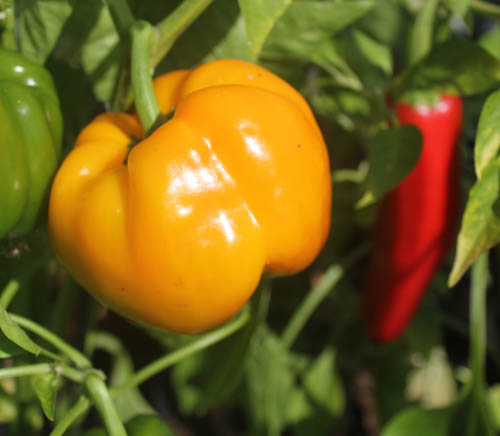
Early October is the time to check your glasshouse, so it is ready when temperatures drop.
Pick the last of your last tomatoes, sweet peppers and chillies, and ripen them on a sunny windowsill or in a paper bag with a ripe banana or pear (the already ripe fruit will produce ethylene will ripen your crops). Blemish free tomatoes can be stored in a cool drawer and ripened in the fruit-bowl as needed during the winter. (I remember my mother doing this, in the chest of draws in my bedroom, when I was a child; top draw: jumpers, second draw, trousers, third draw tomatoes, fourth draw, socks!) Check stored tomatoes regularly, removing any showing signs of decay and make sure the fruit are not packed too closely or are touching each other.
Tomatoes growing in the greenhouse can be lifted and composted. Tidy the greenhouse removing weeds and plant debris, then on a warm, sunny day, clean the glass inside and out. If you use a brush and warm soapy water, rinse with clean water afterwards, then wipe over the glass with a chamois leather and ventilate the glasshouse so it dries out. Once it has done so, you can insulate the glasshouse with bubble wrap or fleece, making sure you can still open the vents and check that your greenhouse heater is working, there should be enough time to repair it if necessary, before the first frosts. It is worth buying a cheap back-up heater, too, just in case things go wrong (I learned this from experience). There is nothing worse than hearing frost warnings and being unprepared. If you don’t want to bubble wrap the whole greenhouse (it’s a real chore), you can put layers of horticultural fleece over the plants instead. Plants that are particularly tender go under the benches for added protection, and make sure the compost has almost dried out too (for more details, please see: https://hartley-botanic.co.uk/wp-content/uploads/2017/07/Hartley-guide-greenhouse-gardening.pdf). Ventilate the greenhouse during sunny autumn days, shutting the windows by the middle of the afternoon to trap the warm air, so it cools down slowly as the day draws on.
Once the first frosts have blackened the plants, cut back the foliage to within 5cm of the base and cover with a thick mulch of well-rotted organic matter or forest bark. In colder climates tubers of tender plants like Dahlias and Cannas should be lifted and stored in a cool frost-free place. Make sure the labels stay with the tubers, turn them upside down for a few weeks, so water drains from the hollow stems, then turn them upright and store them in trays with the tubers covered in compost as protection – spent compost from hanging baskets and containers is ideal.
Bring tender plants like fuchsias, pelargoniums and marguerites into a cool, frost-free greenhouse, cut back the stems to within 10-15cm of the base to save space and keep them just moist over winter.
Sow sweet peas in October or November, germinate them by putting the seed between pieces of damp kitchen towel for 48 hours, then transplant into deep pots, ‘Root Trainers’ or sections of cardboard from the centre of the kitchen roll, to protect them from mice.


